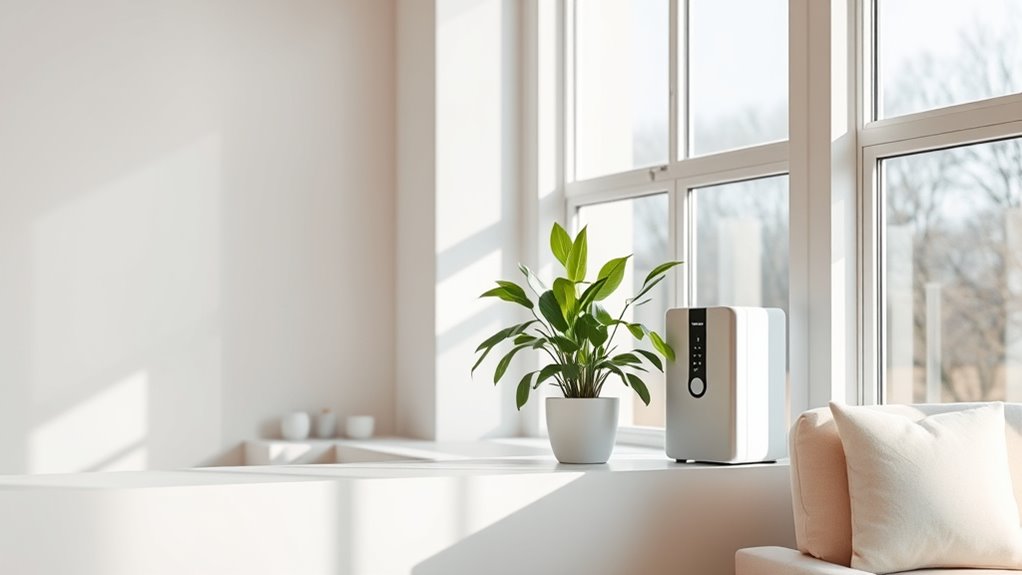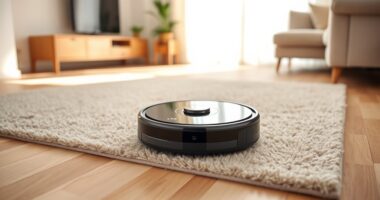To improve indoor air quality, make certain your home is well-ventilated by opening windows and using exhaust fans to circulate fresh air. Use air purifiers with good filters, and replace HVAC filters regularly to keep the air clean. Control humidity levels between 30-50% to prevent mold, and reduce indoor pollutants by choosing low-VOC products. Adding indoor plants can also help filter toxins naturally. Keep exploring for more tips to create a healthier environment.
Key Takeaways
- Ensure proper ventilation by opening windows and using exhaust fans to circulate fresh air and reduce indoor pollutants.
- Regularly replace HVAC and air purifier filters with high-efficiency options to maintain optimal air quality.
- Control indoor humidity levels between 30-50% to prevent mold growth and reduce moisture-related pollutants.
- Minimize indoor pollutants by using low-VOC products, cleaning regularly, and removing sources of dust and pet dander.
- Incorporate indoor plants with air-purifying properties to naturally filter pollutants and improve air quality.
Keep Your Home Well-Ventilated
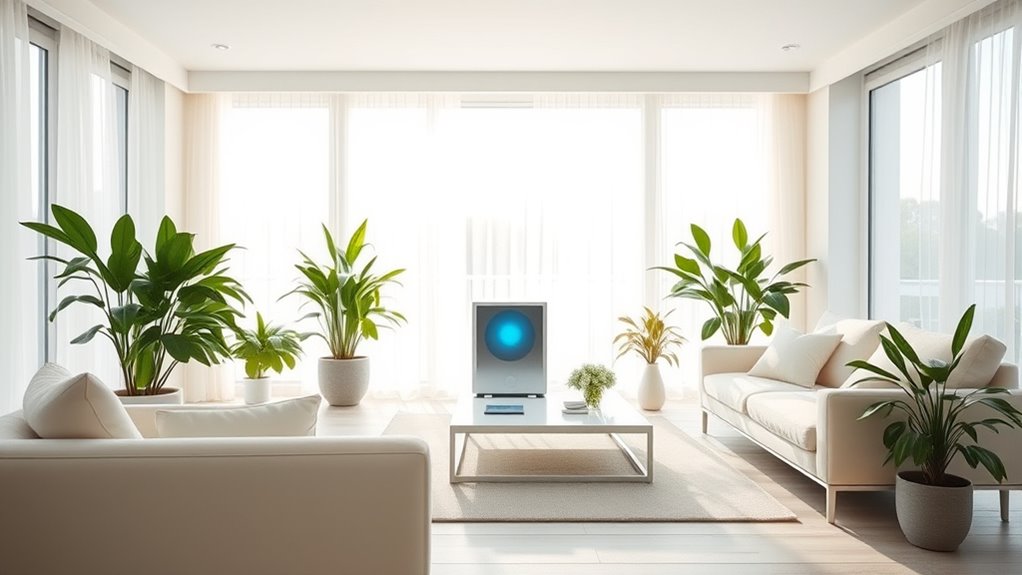
Keeping your home well-ventilated is essential for maintaining good indoor air quality. Natural ventilation allows fresh air to circulate without relying on mechanical systems, helping to remove indoor pollutants. You can encourage this by opening windows on opposite sides of your home to create cross breezes, which effectively push stale air out and draw in cleaner air. Strategically positioning windows and vents maximizes airflow, especially during mild weather. Cross breezes are particularly effective because they use wind to naturally ventilate rooms, reducing the buildup of indoor pollutants and excess moisture. Regularly ventilating your space helps prevent mold growth and keeps indoor air fresh. Incorporating natural ventilation methods is a simple, energy-efficient way to improve your home’s air quality daily. Additionally, understanding the importance of good ventilation practices can help optimize ventilation effectiveness in your home. Ensuring proper air exchange rates can further enhance indoor air quality by removing pollutants more efficiently. Properly managing airflow dynamics is key to achieving optimal indoor air quality.
Use Air Purifiers Effectively
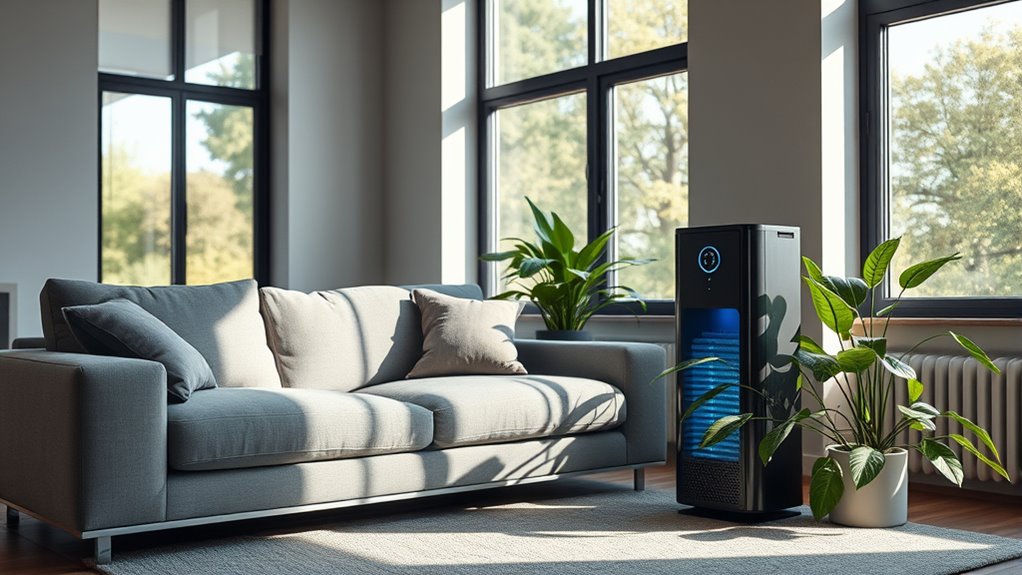
To get the most out of your air purifier, you need to place it in the right spot—preferably where air flows freely and away from obstructions. Regularly check and replace filters to keep it working efficiently and guarantee clean air. Proper maintenance makes a big difference in improving your indoor air quality. Additionally, choosing an air purifier with advanced automation technologies can help optimize performance and ensure consistent air quality. Incorporating features like sensor-based air quality monitoring can further enhance your device’s effectiveness in maintaining healthy indoor environments. Staying informed about latest AI advancements can also help you select the most effective and innovative air purifiers for your needs.
Proper Placement Strategies
Proper placement of air purifiers is essential for maximizing their effectiveness in improving indoor air quality. To do this, consider furniture placement; avoid blocking the purifier’s intake and outlet vents with large furniture pieces, which can restrict airflow. Position the purifier in open areas where air can circulate freely, ideally away from corners or enclosed spaces. Appliance positioning also matters—keep the purifier away from heat sources or appliances that emit fumes, as these can compromise its efficiency. Place the device at a central location within the room to ensure even coverage, and avoid placing it near windows or doors where outside air can bypass the purifier. By strategically positioning your air purifier, you optimize airflow and enhance its ability to filter pollutants effectively. Additionally, understanding air circulation patterns can help you choose the best placement to improve overall air quality. Being aware of air quality monitoring can further assist in assessing the effectiveness of your placement choices.
Maintenance and Filter Care
Regular maintenance and attentive filter care are key to guaranteeing your air purifier works effectively over time. To maximize filter lifespan, change filters as recommended by the manufacturer, typically every 3 to 6 months. Using allergy-friendly filters can also markedly improve indoor air quality, especially if you suffer from allergies or asthma. Regularly inspecting and replacing filters prevents buildup of dust, mold, and other pollutants that can hinder performance. Keep the air purifier clean, including its vents and exterior, to maintain ideal airflow. If your purifier has a filter indicator, don’t ignore it; it’s a helpful reminder to replace filters promptly. Proper filter care not only extends the device’s life but also ensures you’re continuously breathing cleaner, healthier air. Additionally, understanding the importance of indoor air quality can motivate consistent maintenance to ensure optimal purification. Maintaining good air quality supports overall health and well-being by reducing exposure to harmful airborne contaminants. Regularly cleaning the filters and filter replacement indicators can help detect when maintenance is needed before performance declines. Being aware of air purifier maintenance dos and don’ts can further prevent damage and improve efficiency over time.
Maintain and Replace HVAC Filters Regularly
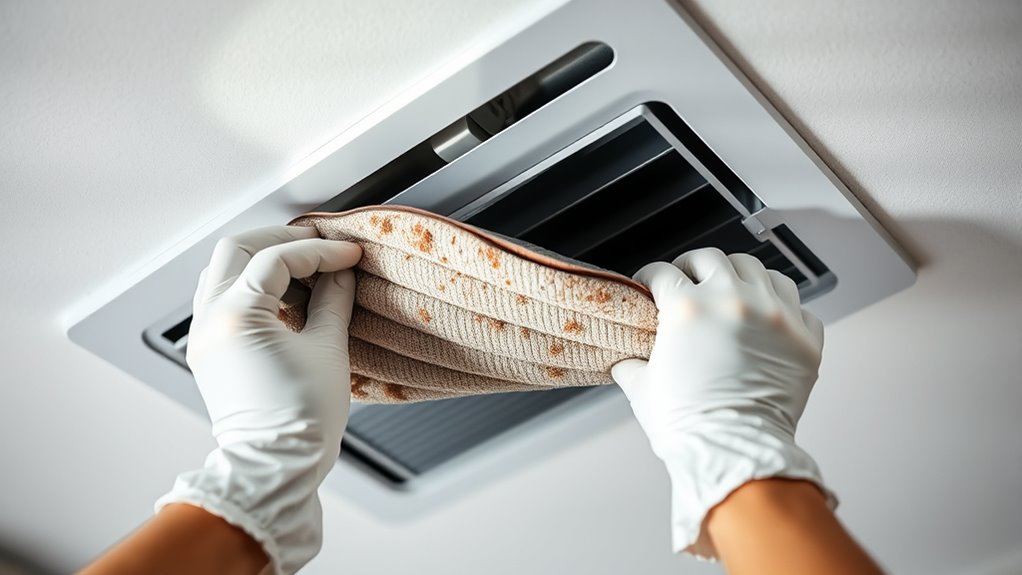
Choosing the right filter material can make a big difference in air quality, so consider options like pleated or HEPA filters for better filtration. You should also adhere to a regular replacement schedule—typically every 1 to 3 months—to keep your system running efficiently. Regularly checking and changing your filters ensures cleaner air and helps your HVAC last longer. Additionally, selecting HEPA filtration filters provides enhanced removal of airborne allergens and pollutants for healthier indoor air. To maximize benefits, consider filters with advanced filtration technology, which can further improve indoor air quality. Monitoring your support hours can also help if you encounter issues with your HVAC system or filters. Incorporating remote work principles into your maintenance routine, such as scheduling filter checks during breaks, can improve overall efficiency.
Filter Material Choices
Selecting the right filter material is essential for maintaining good indoor air quality, as it directly affects the efficiency of your HVAC system and the air you breathe. Different materials offer varying levels of filter material effectiveness and allergen filtration. For ideal results, choose filters made from high-quality fibers that trap tiny particles without restricting airflow. Consider filters with a higher MERV rating for better allergen filtration, especially if allergies are a concern. Be aware that some materials, like electrostatically charged filters, enhance particle capture. Regularly inspecting and choosing the appropriate filter material ensures your system runs efficiently while providing cleaner indoor air. Additionally, filter maintenance and timely replacements are vital to sustain optimal filtration performance and indoor air quality. Advances in filter technology, such as smart filters that monitor airflow and filter health, can further improve your indoor environment. Proper filter selection based on your specific needs can significantly contribute to healthier indoor air.
Replacement Schedule Tips
To guarantee your indoor air stays clean and your HVAC system runs efficiently, it’s important to replace filters on a consistent schedule. Knowing the filter lifespan helps you determine the right replacement frequency, preventing dirt buildup and maintaining good air quality. Typically, filters should be changed every 1 to 3 months, but this can vary based on factors like filter type, household size, and indoor air quality. Regular replacements ensure your system doesn’t strain, saving energy and extending its lifespan. Keep an eye on the filter’s condition and set reminders to replace it on time. Choosing the right filter type can also impact how often you need to replace it. By sticking to a proper schedule, you’ll improve indoor air quality and keep your HVAC system functioning smoothly. Additionally, being aware of local air quality can help you determine if more frequent changes are necessary. To further optimize air quality, consider using self-watering plant pots to maintain healthy indoor plants that naturally filter the air.
Control Humidity Levels to Prevent Mold
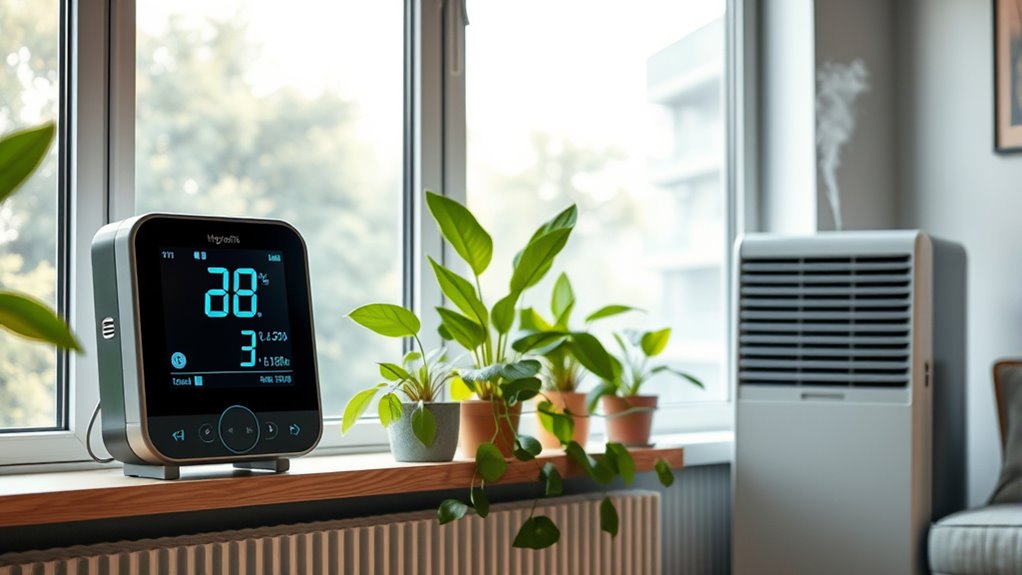
Controlling humidity levels is crucial in preventing mold growth indoors. When humidity exceeds 60%, mold can thrive. To keep levels in check, consider proper dehumidifier selection, ensuring it suits your space’s size and needs. Using mold resistant materials in areas prone to moisture, like bathrooms and basements, also helps prevent mold development. Maintain indoor humidity between 30-50% for ideal air quality. Regularly monitor humidity with a hygrometer. Additionally, improve ventilation by opening windows or using exhaust fans to reduce excess moisture. Proper ventilation methods help circulate fresh air and further reduce humidity levels. Incorporating humidity control techniques can enhance your efforts in creating a healthier indoor environment. These steps create an environment less hospitable to mold, safeguarding your indoor air quality. Remember, controlling humidity isn’t just about comfort—it’s essential for a healthier home. Proper dehumidifier selection ensures effective moisture control.
Minimize Indoor Pollutants and Allergens
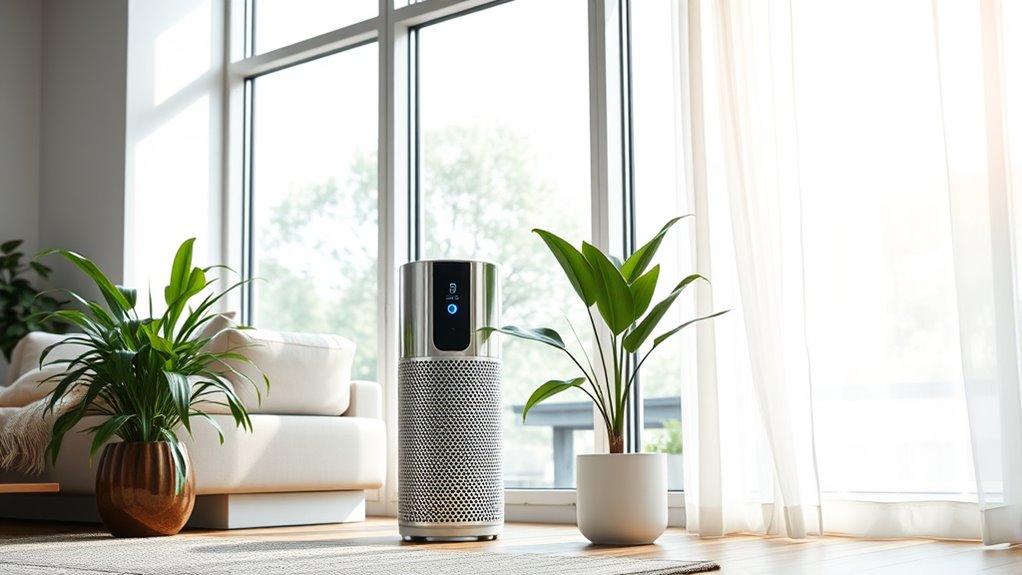
Indoor pollutants and allergens can considerably impact your health if not properly minimized. Chemical emissions from cleaning products, paints, and furniture can release harmful toxins into the air. To reduce these, choose low-VOC or VOC-free items and ventilate well during and after use. Allergen sources, like pet dander, dust mites, and mold spores, also contribute to indoor air pollution. Keep surfaces clean and wash bedding regularly to reduce dust and pet allergens. Use high-efficiency filters in your HVAC system to trap airborne particles and consider using allergen-proof covers on pillows and mattresses. Avoid clutter that traps dust, and maintain good hygiene practices to limit allergen accumulation. Taking these steps helps create a healthier indoor environment by minimizing pollutants and allergens effectively.
Incorporate Indoor Plants to Improve Air Quality
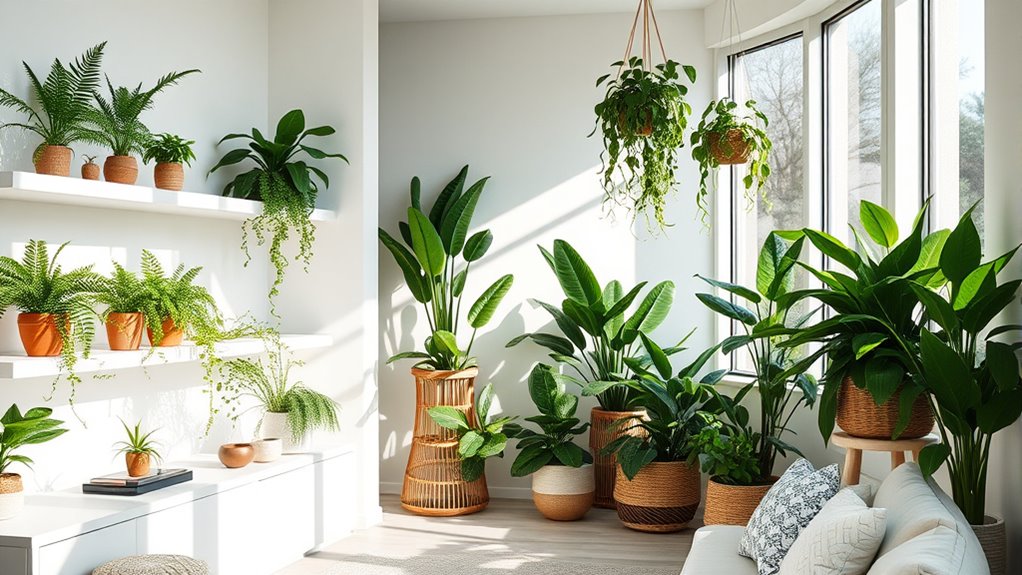
Incorporating indoor plants can substantially enhance your air quality by naturally filtering pollutants and increasing humidity. Choosing the right plants is key; opt for varieties like snake plants, pothos, or peace lilies known for their air-purifying properties. Proper plant selection and care tips ensure your greenery thrives and maximizes air-cleaning benefits. To get started, consider lighting, watering, and humidity needs for each plant to maintain their health. Regularly dust the leaves to optimize pollutant absorption. Incorporate plants into your space thoughtfully, placing them where they’ll get adequate light and where you spend the most time. These simple steps can make a significant difference in creating a fresher, healthier indoor environment.
- Select plants suited to your indoor conditions
- Follow specific watering and lighting care tips
- Position plants strategically for maximum impact
Frequently Asked Questions
How Do I Choose the Best Air Purifier for My Home?
When choosing the best air purifier, consider its features like HEPA filters, noise levels, and ease of use. Make sure it’s compatible with your room size to effectively clean the air. You should also look at energy efficiency and filter replacement costs. By matching the purifier’s features and room size compatibility, you guarantee peak performance, helping you breathe cleaner air every day.
What Are the Signs My HVAC Filters Need Replacing?
You’ll know your HVAC filters need replacing when you notice decreased airflow or increased dust and allergens. Over time, filters reach their filter lifespan, and allergen buildup reduces their effectiveness. Check your filters regularly—if they look dirty, clogged, or discolored, it’s time for a change. Replacing filters promptly guarantees your system runs efficiently, maintains good airflow, and keeps indoor air cleaner for you.
How Can I Effectively Reduce Pet Dander Indoors?
To effectively reduce pet dander indoors, start by regularly grooming your pets to minimize loose pet hair. Use high-efficiency filters in your HVAC system to trap allergens and prevent tracking throughout your home. Vacuum frequently with a HEPA filter vacuum, especially in areas your pets frequent. Wash pet bedding often, and create pet-free zones to limit allergen buildup. These steps help reduce airborne pet hair and allergens, making your home healthier and more comfortable.
Are There Specific Indoor Plants That Filter Toxins Better?
Think of your space as a invigorating gust of fresh air waiting to happen. Toxin-absorbing plants like spider plants, snake plants, and peace lilies act as natural air purifiers, transforming your indoor environment into an oasis of clean air. Air purifying greenery doesn’t just decorate; it filters out harmful toxins, making your home healthier. By choosing these plants, you turn your living space into a sanctuary where every breath feels lighter and brighter.
What Are the Health Risks of Poor Indoor Air Quality?
Poor indoor air quality can cause health symptoms like headaches, dizziness, and respiratory issues. You might also experience eye irritation or fatigue. If left unaddressed, long-term effects could include asthma, heart disease, or even lung cancer. Breathing polluted air regularly stresses your immune system and damages your lungs over time. To protect your health, it is crucial to improve indoor air conditions and reduce exposure to harmful pollutants.
Conclusion
By keeping your home well-ventilated and using air purifiers, you create a fresh, healthy environment. Regularly maintaining filters and controlling humidity prevent unseen dangers like mold and allergens. Yet, despite these efforts, indoor air quality can still be compromised by everyday pollutants. Remember, choosing to improve your indoor air isn’t just about cleanliness—it’s about safeguarding your health and well-being in a space where you should always feel safe and comfortable.
